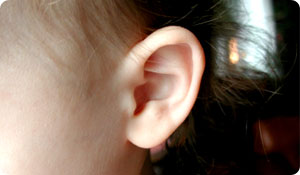
Ear infections are common, especially in children. In fact, about 75 percent of all children will probably have an infection before they turn three, according to National Institute on Deafness and Other Communication Disorders (NIDCD). Older children will probably complain of ear pain and small children who cannot speak well are likely to pull or rub their ear. What do you need to know if you suspect that your child has an ear infection?
Anatomy of the Ear
First, it helps to understand the anatomy of the ear. It is divided into three parts: outer, middle and inner. The outer ear consists of the part of the ear you can see and the eardrum. The inner ear is where the organs that help you hear are located, the NIDCD explains.
The middle ear is a passage that contains a small pocket of air behind the eardrum. Most ear infections occur here. An infection in this area occurs when germs enter the middle ear, and the area fills with fluid. Your ear could start to feel like a balloon that is ready to burst-a feeling that can cause a great deal of pain even for an adult, according to the Nemours Foundation.
Symptoms of an Ear Infection
Children (and adults) who have ear infections may have the following symptoms, according to the American Academy of Pediatrics.
- Ear Pain
- Loss of appetite
- Trouble sleeping due to the pain.
- Fever.
- Yellow or white fluid draining from your child's ear.
- Trouble hearing.
If your child does not yet talk, look for these signs of infection from the National Institutes of Health (NIH).
- Tugging at ears
- Crying more than usual
- Ear drainage
- Trouble sleeping
- Balance difficulties
- Hearing problems
Treating Ear Infections
If you think you or your child has an ear infection, talk to your doctor. Often, ear infections go away on their own, but your health care provider may recommend pain relievers or antibiotics (if there are signs that it is a bacterial infection).
If your child has experienced multiple infections, your physician may choose to run additional tests. Children who get frequent infections may need surgery to place small tubes inside their ears. The tubes relieve pressure in the ears so that the child can hear again, according to the NIH.
Preventing Ear Infections
You can't catch an ear infection from another person, but you can catch a cold, which could lead to an ear infection. Generally, symptoms of ear infection include ear pain, a fever and/or trouble hearing.
To prevent ear infections, the Nemours Foundation recommends the following:
1. Avoid smoking
2. Avoid people with colds
3. Wash your hands frequently
4. Avoid touching your nose or eyes
Also protect yourself against swimmer's ear, which is an outer ear infection caused by bacteria or fungi. It is most common in people who spend a great deal of time in the water, according to the Nemours Foundation. It may also be caused by excessive dry skin in or near the ear or harsh cleaning with cotton swabs.
If you have any questions or concerns about your health or the health of your child, please speak with your health care provider. He or she should be able to discuss conditions and options with you.





